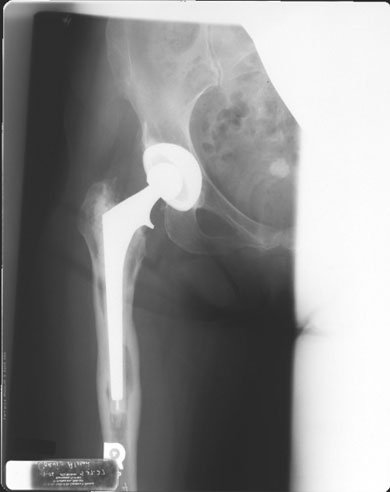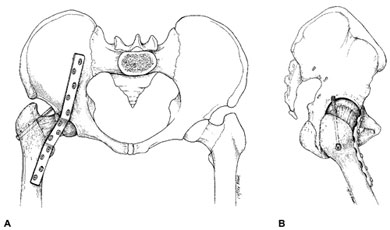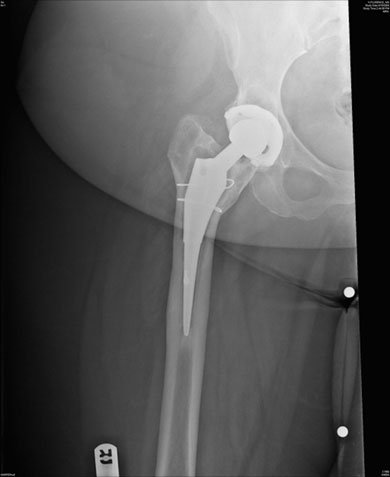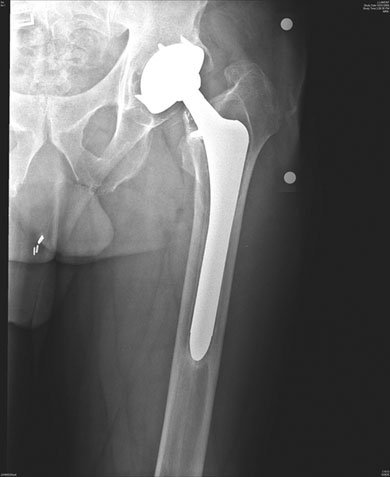I Have a Patient With Start-Up Thigh Pain 5 Years After Surgery, and I Think the Femoral Component Is Loose. How Can I Tell for Sure?
Thigh pain 5 years after a total hip replacement can be caused by a variety of conditions. Although aseptic loosening is always a possibility, extrinsic and other intrinsic causes of pain must always be ruled out.
I first like to rule out the extrinsic causes of pain. Thigh pain with tenderness over the greater trochanter may be caused by trochanteric bursitis. Local anesthetic injection into the trochanteric bursa administered with a form of steroid is both diagnostic and therapeutic. Spine disease, such as thoracolumbar discogenic pain, L3-4 posterior-lateral disc herniations or L4-5 foraminal disc herniations, may also cause groin and thigh pain, with or without associated low back pain. As such, I like to do a thorough back examination to rule out such conditions.
A loose femoral component often causes “start-up” pain: anterior thigh pain or knee pain that worsens with ambulation. Perhaps due to the component obtaining a stable position within the femoral canal, this pain often subsides with prolonged ambulation. On occasion, patients may present with an external rotation contracture due to the loose femoral component rotating into retroversion. Subjective feelings of the hip “giving out” may also be associated with a loose femoral component. This is most likely related to shortening of the limb and associated decrease in soft-tissue tension at the level of the hip joint.
During the physical exam of a patient with a loose femoral component, I commonly observe an antalgic gait caused by motion of the stem within the femoral canal. With significant stem subsidence, I often see an abductor lurch: as the abductors shorten they are at a biomechanical disadvantage. I have on occasion measured limb-length discrepancies, with the affected side being shorter. I find my patients rarely complain of this shortening, as it most likely occurred over a long period of time and they have gotten used to it. Many patients who have loose femoral components experience thigh pain when asked to perform an active straight leg raise in the supine position. Passive internal and external rotation of the hip joint occasionally causes thigh pain, but not always. Vastus lateralis muscle herniation through a defect in the fascia lata is an unusual cause of thigh pain that has been described. This can be palpated as a mass when the muscle is tensed.
Infection as the cause of pain after total hip replacement must always be ruled out. Pain while at rest, night pain, fevers, chills, recent dental procedures, other hip procedures prior to the hip replacement, or prolonged wound drainage after the index procedure all raise my suspicion for infection. These patients often have radiographs that show endosteal scalloping, generalized osteolysis, and periosteal new bone formation (Figure 19-1). I like to check a complete blood count with differential (CBC), erythrocyte sedimentation rate (ESR), and a C-reactive protein (CRP). If any of these values are elevated and the patient does not have other sources of infection, I will aspirate the hip under fluoroscopic guidance.

Figure 19-1. Preoperative roentgenogram of a symptomatic patient 3 years after total hip replacement. Note endosteal scalloping, generalized osteolysis, and cortical hypertrophy. Intraoperative cultures confirmed prosthetic joint infection.
To make the diagnosis of a loose femoral component, I rely predominantly on plain radiographs. I routinely obtain a standard anterior posterior (AP) pelvic radiograph and AP, frog lateral, and cross-table lateral of the affected hip. Digital radiographs allow quality optimization so that the interface between the bone and prosthesis, cement and prosthesis, or cement and bone can be visualized. Standard radiographs that patients bring in themselves must be less than a week old and be of sufficient quality to be used for evaluation. As radiographic signs are often subtle and progress slowly, comparison of serial radiographs is critical in the evaluation of a prosthetic joint replacement. My staff spends a great deal of energy assisting patients in the process of obtaining these films.
I assess the stability of cemented and cementless implants using different criteria. For cemented femoral implants, especially those designed to bond to the cement mantle, I look for radiolucent lines at the prosthesis-cement interface suggestive of debonding. I then evaluate the bone-cement interface. One of the following findings indicates to me “definite” component loosening: migration of the component, fracture of the stem, or cement fracture. A continuous radiolucent line at the bone-cement interface (Figure 19-2) that is greater than 2 mm in width tells me that the component is “probably loose.” When that line is present between 50% and 100% of the total bone-cement interface, the stem is “possibly loose.” When old radiographs are available for review, the “probably loose” and the “possibly loose” implants become “definitely loose” if these lines are progressive. If the radiolucencies just described were present on radiographs taken soon after the surgery, or if these early radiographs are not available for evaluation, I order a technetium 99 methylene diphosphonate scan. If the scan reveals normal findings, I continue my search for extrinsic causes of hip pain. If the scan is positive and it has been more than 2 years since the surgery was done, I discuss revision surgery with the patient.

Figure 19-2. Preoperative roentgenogram of a symptomatic patient 15 years after total hip replacement and 3 years after revision of the acetabular component. Note circumferential radiolucencies, cortical discontinuity, and cement fracture. Gross loosening was confirmed intraoperatively.
In patients who have had their hip replacement done many years prior to their evaluation, I interpret radiolucent lines at the femoral bone-cement interface with more caution than in those who have had their surgery done more recently. In these generally older patients, radiolucent lines may indicate internal bone remodeling rather than loosening at the bone-cement interface.
I assess cementless femoral components using different criteria (Figures 19-3 and 19-4). Regardless of fixation zone (proximal or distal), the presence of progressive implant migration on serial radiographs is highly suggestive of implant loosening. On the other hand, absence of reactive lines or presence of “endosteal” spot welds around the porous-coated part of the prosthesis are highly consistent with a well-fixed implant.

Figure 19-3. Preoperative roentgenogram 6 years after placement of a cementless proximally fixed tapered stem. Note subsidence, radiolucent lines, and formation of a pedestal. Gross loosening was confirmed intraoperatively.

Figure 19-4. Preoperative roentgenogram 7 years after placement of a fully coated cementless stem. Note subsidence, bead shedding, radiolucent lines, lack of spot welds, and early pedestal formation.
Visualizing spot welds on proximally porous-coated implants or on extensively coated implants that are canal filling is often difficult. As such, I also look for other “minor” signs of osseointegration. These include calcar atrophy, the absence of bead shedding, and the absence of a pedestal. Pedestals without associated radiolucent stems, however, must be interpreted with caution—they are not always indicative of loosening. Cortical hypertrophy proximally in a collared implant may indicate loosening, whereas cortical hypertrophy distally in a fully coated implant is suggestive of osseointegration. As with cemented implants, it is rare that I use nuclear imaging to evaluate a patient’s femoral component. On the rare occasion that I obtain these tests, however, I interpret them with caution, especially when the results are abnormal.
Diagnosing a loose femoral component is not always easy. Although other techniques such as fluoroscopy, arthrography, and dynamic computerized tomography have been evaluated in the scientific literature, I rarely find these tests necessary. Currently, I find comparison of serial radiographs to be the most useful method for making the appropriate diagnosis. When loosening, infection, and extrinsic causes of hip pain have been ruled out, other causes of thigh pain must be worked up. These include mismatch in the modulus of elasticity between an implant and host bone, stress fractures, and oncological processes.
Bibliography
Engh CA, Massin P, Suthers KE. Roentgenographic assessment of the biologic fixation of porous-surfaced femoral components. Clin Orthop Relat Res. 1990;257;107-128.
Higgs JE, Chong A, Haertsch P, Sekel R, Leicester A. An unusual cause of thigh pain after total hip arthroplasty. J Arthroplasty. 1995;10(2):203-204.
O’Neill DA, Harris WH. Failed total hip replacement: assessment by plain radiographs, arthrograms, and aspiration of the hip joint. J Bone Joint Surg Am. 1984;66(4):540-546.
Tehranzadeh J, Schneider R, Freiberger RH. Radiological evaluation of painful total hip replacement. Radiology. 1981;141(2):355-362.
